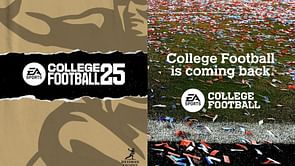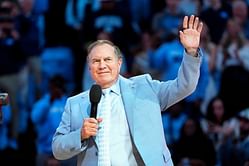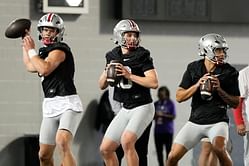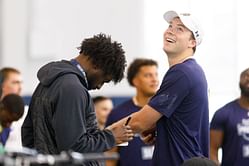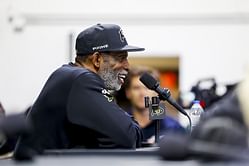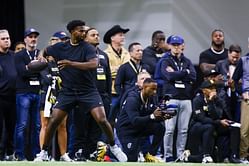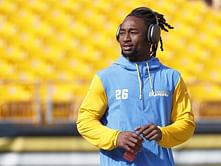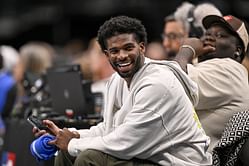
The Heisman Trophy is awarded annually to the college football player who showcases talent, effort, and dedication. The Downtown Athletic Club established the trophy in 1935, and it is presently awarded by the Heisman Trophy Trust in the first week of December, prior to postseason bowl games.
It was intended for the "most valuable college football player east of the Mississippi," but after the club's athletic director, John Heisman, passed away in 1936, the award was renamed in his honor. Jayden Daniels, a former quarterback of the LSU Tigers, is the most recent recipient of the Heisman Trophy.
Heisman Trophy award day is scheduled for December 14, 2024. The four candidates for the award will be made public on December 9, 2024. The Heisman Trophy voting ballots were made available on December 2. The event will be covered by ESPN as part of an hour-long telecast.
The Heisman Trophy Design
The club trophy committee at the Downtown Athletic Club in New York decided that the award would be a bronze sculpture of a football player driving for yardage.
Sculptor Frank Eliscu based the trophy's design on Ed Smith, a star player for the now-defunct New York University football team in 1934. The trophy is 13.5 inches (34.3 cm) in height, 14 inches in length, and 16 inches in width. It is made of cast bronze and weighs 45 pounds (20.4 kg). The DAC Committee approved Eliscu's original rough clay study, which was then forwarded uptown for approval by Jim Crowley, the head football coach at Fordham University and one of the fabled Four Horsemen of Notre Dame. Crowley's players were told to assume several positions while the prototype was set up on a field in order to demonstrate and test the side step, the forward drive, and the strong right arm push. The artist updated his clay prototype after carefully observing them.
The result was an accurate simulation of a player in action. Having said that, it was first created in bronze after being cast in plaster. On November 16, 1935, after dinner at the McAlpin Hotel, the cast had its last scrutiny. The new trophy was approved that evening by the 1935 Notre Dame team. The sculpture was created using the age-old lost wax method of bronze casting. The Trophy's final iteration depicts a strong and skilled football player sidestepping and straight-arming his way to a touchdown. From 1935 to 1980, when Dieges & Clust was acquired by Herff Jones, the statue was cast in New York by Dieges & Clust. The trophy has been created by MTM Recognition in Del City, Oklahoma, since 2005.
The Heisman Trophy Milestones
| Year | Milestones |
| 1935 | At the completion of the 1935 football season, the Downtown Athletic Club (DAC) in New York elects a Club Trophy Committee tasked with organizing the presentation of the first trophy in the club's headquarters, which are situated at the southern tip of Manhattan. On December 9, 1935, Jay Berwanger, a triple threat cyclone and renowned "one-man-gang" in the University of Chicago's backfield, received the first honor, which at the time was known as the DAC Trophy. |
| 1936 | After the passing of renowned football coach and DAC athletic director John W. Heisman on October 3, 1936, the prize was renamed the Heisman Memorial Trophy. |
| 1943 | A military jet carrying the Heisman winner from Iowa in 1939, Nile Kinnick, crashes off the coast of South America, making him the first Heisman winner to lose his life. |
| 1945 | Felix "Doc" Blanchard, a fullback for the Army, becomes the first junior to win the Heisman Trophy. |
| 1951 | The third and most recent Ivy League player to win the Heisman is Princeton's outstanding running back, Dick Kazmaier. |
| 1956 | Paul Hornung of Notre Dame becomes the lone player to win the Heisman Trophy for a losing team. The Irish finished at 2–8. |
| 1961 | Syracuse running back Ernie Davis wins the Heisman Trophy, becoming the first African-American to do so. He sadly passed away from leukaemia in 1963. |
| 1962 | Terry Baker of Oregon State is the first West Coaster to win the Heisman Trophy. Additionally, he was the only Heisman winner to participate in the 1963 NCAA basketball Final Four. |
| 1963 | Five Heismans were won by Service Academy institutions in the first 25 years of the award's existence, but Navy quarterback Roger Staubach is the last individual to do so. |
| 1972 | Johnny "The Jet" Rodgers won the Heisman Trophy as the inaugural wide receiver. |
| 1973 | The Heisman dinner was previously held in the Downtown Athletic Club, but its rising popularity necessitated a relocation to the Grand Ballroom of the New York Hilton. There it would remain until 1986. |
| 1975 | Archie Griffin of Ohio State becomes the first Heisman winner to have won the award twice, in 1974 and 1975. |
| 1977 | The Heisman Award will be presented as part of an hour-long, prime-time television extravaganza, as decided by the Heisman Committee and the President of the DAC. |
| 1981 | Marcus Allen of USC is the first Heisman winner to have an ABC-sponsored live television announcement. |
| 1982 | Finalists will travel to New York for the first time to participate in the live, ABC-broadcast Heisman ceremony. Herschel Walker, John Elway, and Eric Dickerson are the Heisman Trophy finalists; Elway was not present. |
| 1984 | Doug Flutie of Boston College ends an 11-year streak of running-back winners by becoming the first quarterback since Pat Sullivan in 1971 to win the Heisman Trophy. |
| 1996 | Danny Weurffel's victory for the Gators makes Steve Spurrier, the head coach of Florida, the first Heisman winner to coach another Heisman winner. |
| 1997 | Regardless of his all-around talent as a three-way player, Michigan cornerback Charles Woodson becomes the first athlete to win the Heisman who focuses primarily on defense. |
| 2001 | In 2001, the Heisman presentation was relocated to the New York Marriott Marquis due to the tragic events of September 11. It relocated to the NYC Yale Club in 2002 and 2003. In 2004, the announcement was held in the New York Hilton, and in 2005, it was relocated to the recently refurbished Nokia Theatre (now the Playstation Theatre) in the heart of Times Square's Broadway Theater area. |
| 2006 | After the Lower Manhattan terror attacks of 2001, the Downtown Athletic Club was shut down, and the Heisman Trophy was transferred to a charitable organization that supports underprivileged children and amateur athletic causes, the Heisman Trust. |
| 2007 | Heisman voting shifted to an online ballot in its entirety in 2007. By 2009, all Heisman ballots had to be submitted online, allowing voters to postpone their selections until the last regular-season game. Tim Tebow, a quarterback for Florida, is the first sophomore to win the Heisman Trophy. He is the first of three consecutive sophomores from 2007 to 2009 to win the honor. |
| 2012 | Johnny Manziel, a quarterback for Texas A&M, is the first redshirt freshman to win the Heisman Trophy. The next year, Florida State redshirt freshman quarterback Jameis Winston succeeds him as the Heisman winner. |
| 2015 | Derrick Henry of Alabama, a junior, wins the Heisman Trophy for the ninth time in a row. |
FAQs on Heisman Trophy
A. Jay Berwanger received the first Heisman Trophy on December 9, 1935.
A. John W. Heisman's passing in 1936 led to the renaming of the trophy from the DAC Trophy to the Heisman Memorial Trophy.
A. Felix "Doc" Blanchard, who joined the Army in 1945, was the first junior to win the Heisman Trophy.
A. Ernie Davis, from Syracuse in 1961, was the first African-American to win the Heisman Trophy.
A. In 2007, all Heisman voting moved to an online ballot, providing more flexibility for voters.
